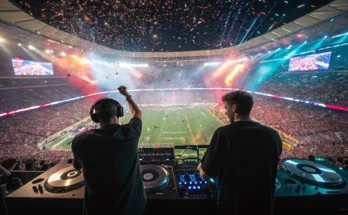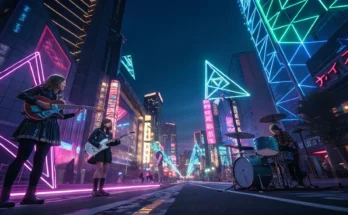Introduction
Electronic music has become a significant force in modern music culture, shaping the way we create, consume, and experience music. With its origins dating back to the early 20th century, electronic music has evolved and diversified over the years, giving rise to various sub-genres and styles. From the experimental sounds of early pioneers to the mainstream success of artists like Daft Punk and Calvin Harris, electronic music has had a profound impact on popular culture.
The Rise of Electronic Music: A Brief History
The history of electronic music can be traced back to the early 20th century, with pioneers like Karlheinz Stockhausen and Pierre Schaeffer experimenting with tape manipulation and musique concrète. These early experiments laid the foundation for the development of synthesizers and other electronic instruments in the 1960s and 1970s.
In the 1980s, electronic music began to gain mainstream popularity with the emergence of techno and house music. Artists like Juan Atkins, Derrick May, and Kevin Saunderson pioneered these genres, blending elements of disco, funk, and synth-pop to create a new sound that would go on to influence generations of musicians.
The impact of electronic music on popular culture cannot be overstated. From its influence on fashion and visual art to its role in shaping youth culture and nightlife, electronic music has become a global phenomenon that transcends borders and genres.
The Digital Revolution and its Impact on Electronic Music
The advent of digital technology revolutionized the production and distribution of electronic music. With the shift from analog to digital production, musicians gained access to a wide range of tools and software that allowed for greater flexibility and creativity in their work.
The democratization of music creation and distribution was another significant outcome of the digital revolution. With affordable software and hardware becoming more accessible, anyone with a computer could now produce their own electronic music. This led to an explosion of new talent and a diversification of styles and sub-genres within the electronic music scene.
The rise of online music platforms and streaming services further transformed the way we consume electronic music. With platforms like SoundCloud and Spotify, artists could now reach a global audience without the need for traditional record labels or physical distribution. This shift in distribution models has had a profound impact on the industry, allowing for greater independence and control for artists.
The Globalization of Electronic Music: A Cultural Phenomenon
Electronic music has spread across the world, transcending cultural boundaries and fusing different influences to create unique sounds and styles. From the underground clubs of Detroit to the beaches of Ibiza, electronic music has become a global cultural phenomenon.
The fusion of different cultural influences in electronic music has led to the emergence of sub-genres like Afrobeat, Balearic, and K-pop. These sub-genres blend traditional musical elements with electronic production techniques, creating a hybrid sound that reflects the diversity of our globalized world.
Electronic music has also played a significant role in shaping cultural identity. In countries like Germany and the UK, electronic music has become synonymous with youth culture and rebellion. In other parts of the world, it has become a symbol of modernity and progress. The ability of electronic music to connect people across borders and cultures is a testament to its power as a universal language.
The Role of Technology in Electronic Music Production
Technology plays a crucial role in electronic music production, enabling artists to create complex and innovative sounds. From software synthesizers to hardware controllers, musicians have access to a wide range of tools that allow them to push the boundaries of what is possible.
Software like Ableton Live and Logic Pro has become essential for many electronic music producers, offering powerful features for composition, arrangement, and sound design. Hardware controllers like MIDI keyboards and drum machines provide tactile control over virtual instruments, allowing for a more intuitive and expressive workflow.
The impact of technology on creativity and innovation in electronic music cannot be overstated. With the ability to manipulate and shape sound in ways that were previously unimaginable, artists are constantly pushing the boundaries of what is possible. The future of technology in electronic music production holds even more exciting possibilities, with advancements in artificial intelligence and virtual reality opening up new avenues for exploration.
The Evolution of DJ Culture in the Digital Age
DJ culture has evolved alongside electronic music, with DJs playing a crucial role in shaping the sound and direction of the scene. In the early days, DJs would mix records together using turntables and vinyl records, creating seamless transitions between tracks.
The advent of digital technology has revolutionized DJing, with the introduction of CDJs and digital DJ software. These tools allow DJs to manipulate tracks in real-time, adding effects, loops, and samples to create unique and dynamic performances.
The future of DJ culture in the digital age holds even more exciting possibilities. With advancements in technology, DJs will have access to even more powerful tools for live performance and remixing. Virtual reality could also play a role in enhancing the DJ experience, allowing for immersive and interactive performances.
The Influence of Social Media on Electronic Music Marketing and Distribution
Social media has become an essential tool for promoting electronic music and connecting with fans. Platforms like Facebook, Instagram, and Twitter allow artists to share their music, engage with their audience, and build a loyal fan base.
The impact of social media on music distribution and consumption cannot be overstated. With platforms like SoundCloud and Bandcamp, artists can now release their music directly to their fans without the need for traditional record labels or physical distribution. This has led to a democratization of the industry, allowing for greater independence and control for artists.
The future of social media in electronic music marketing holds even more exciting possibilities. With advancements in technology like virtual reality and augmented reality, artists will have new ways to engage with their audience and create immersive experiences. Social media will continue to play a crucial role in connecting artists with their fans and shaping the future of electronic music.
The Future of Electronic Music: Predictions and Trends
The future of electronic music is filled with exciting possibilities. Emerging trends in electronic music production and consumption point towards a continued diversification of styles and sub-genres. Artists will continue to push the boundaries of what is possible, blending different influences and experimenting with new sounds.
The potential impact of new technologies on electronic music is also worth considering. Advancements in artificial intelligence and machine learning could revolutionize the way we create and consume music, with algorithms generating personalized playlists and AI-powered virtual bands creating entirely new sounds.
The future of electronic music is bright, with endless possibilities for innovation and creativity. As technology continues to evolve, so too will the sound of electronic music, pushing the boundaries of what is possible and shaping the future of modern music culture.
The Relationship between Electronic Music and Virtual Reality
The intersection of electronic music and virtual reality holds great potential for enhancing the music experience. Virtual reality technology allows users to immerse themselves in a virtual environment, creating a sense of presence and interactivity.
In the context of electronic music, virtual reality could be used to create immersive live performances, allowing users to experience a concert or DJ set from the comfort of their own home. Virtual reality could also be used to enhance the visual aspect of electronic music, creating interactive visualizations that respond to the music in real-time.
The future of electronic music and virtual reality holds exciting possibilities. As virtual reality technology becomes more accessible and affordable, we can expect to see more artists experimenting with this medium and pushing the boundaries of what is possible.
The Ethics of Sampling and Copyright in Electronic Music
Sampling has been a controversial topic in electronic music, with artists often facing legal and ethical challenges when using copyrighted material in their work. While sampling can be a powerful tool for creativity and innovation, it also raises questions about ownership and intellectual property.
The legal and ethical implications of sampling in electronic music are complex and often subjective. While some argue that sampling is a form of artistic expression and should be protected under fair use laws, others believe that artists should seek permission and pay royalties for the use of copyrighted material.
The future of copyright in electronic music is uncertain. As technology continues to evolve, so too will the ways in which artists create and distribute their music. It is likely that we will see new models emerge that balance the rights of artists with the need for creativity and innovation.
The Importance of Diversity and Inclusivity in Electronic Music Communities
One of the challenges facing electronic music communities is the lack of diversity and inclusivity. Historically, electronic music has been dominated by white male artists, with women and people of color underrepresented in the scene.
Promoting diversity and inclusivity in electronic music communities is crucial for creating a more equitable and inclusive industry. This can be achieved through initiatives like mentorship programs, workshops, and festivals that showcase diverse talent.
Strategies for promoting diversity and inclusivity in electronic music communities include creating safe spaces for marginalized groups, providing opportunities for underrepresented artists to showcase their work, and challenging the stereotypes and biases that exist within the industry.
Conclusion
Electronic music has become a significant force in modern music culture, shaping the way we create, consume, and experience music. From its early pioneers to the mainstream success of artists like Daft Punk and Calvin Harris, electronic music has had a profound impact on popular culture.
The digital revolution has transformed the production and distribution of electronic music, democratizing the industry and allowing for greater creativity and innovation. The globalization of electronic music has led to the fusion of different cultural influences, creating a diverse and vibrant scene that reflects the diversity of our globalized world.
Technology continues to play a crucial role in electronic music production, enabling artists to create complex and innovative sounds. The future of electronic music holds even more exciting possibilities, with advancements in artificial intelligence and virtual reality opening up new avenues for exploration.
As the industry continues to evolve, it is important to promote diversity and inclusivity in electronic music communities, ensuring that all voices are heard and represented. By embracing new technologies and challenging the status quo, we can shape the future of electronic music and continue to push the boundaries of what is possible.
Check out this article on MusicCharts24: “Unlock the Unknown: Underground Spotify Playlist Pitching Tips Revealed.” It provides valuable insights into how independent artists can navigate the digital landscape and gain exposure through curated playlists. Whether you’re an electronic music producer or any other genre, this article offers practical tips and strategies to unlock the potential of Spotify playlist placement. Don’t miss out on this opportunity to expand your reach and connect with new listeners. Read more



